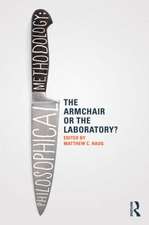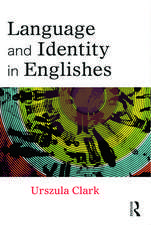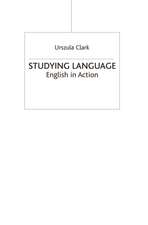Quantitative Research Methods for Linguists: a questions and answers approach for students
Autor Tim Grant, Urszula Clark, Gertrud Reershemius, Dave Pollard, Sarah Hayes, Garry Plapperten Limba Engleză Paperback – 29 iun 2017
Key features include:
- Chapters framed around real research questions, walking the student step-by-step through the various methods;
- Guidance on how to design your own research project;
- Basic questions and answers that every new researcher needs to know;
- A comprehensive glossary that makes the most technical of terms clear to readers;
- Coverage of different statistical packages including R and SPSS.
| Toate formatele și edițiile | Preț | Express |
|---|---|---|
| Paperback (1) | 414.21 lei 6-8 săpt. | |
| Taylor & Francis – 29 iun 2017 | 414.21 lei 6-8 săpt. | |
| Hardback (1) | 762.57 lei 6-8 săpt. | |
| Taylor & Francis – 29 iun 2017 | 762.57 lei 6-8 săpt. |
Preț: 414.21 lei
Nou
Puncte Express: 621
Preț estimativ în valută:
79.26€ • 84.76$ • 66.08£
79.26€ • 84.76$ • 66.08£
Carte tipărită la comandă
Livrare economică 17 aprilie-01 mai
Preluare comenzi: 021 569.72.76
Specificații
ISBN-13: 9780415736329
ISBN-10: 0415736323
Pagini: 164
Ilustrații: 62
Dimensiuni: 156 x 234 x 16 mm
Greutate: 0.25 kg
Ediția:1
Editura: Taylor & Francis
Colecția Routledge
Locul publicării:Oxford, United Kingdom
ISBN-10: 0415736323
Pagini: 164
Ilustrații: 62
Dimensiuni: 156 x 234 x 16 mm
Greutate: 0.25 kg
Ediția:1
Editura: Taylor & Francis
Colecția Routledge
Locul publicării:Oxford, United Kingdom
Public țintă
Postgraduate and UndergraduateCuprins
Part 1: Basic Statistical Ideas
1. Basic concepts of quantification and number
2. Designing research projects which count things
Part 2: Asking and Answering Quantitative Questions
3. Survey of the sexiness of Klingon
4. Who speaks Low German with their children?
5. Frequency of use of the present perfect tense in two newspapers
Comparison of two groups where the data is not normally distributed – Mann Whitney U test
6. Is there a difference in the way ‘ing’ is pronounced by people from Birmingham and the Black Country?
Testing for difference using Chi square
7. Do letter writers tend to use nouns and verbs together?
Scatterplots and correlation of linear data
8. Does the use of pronouns differ between two academic disciplines?
Using T-test to compare between two groups
9. Does the use of pronouns differ between three academic disciplines?
Comparison between three or more groups: One-Way Anova
10. Asking and answering quantitative questions - conclusions
Glossary
Index
1. Basic concepts of quantification and number
2. Designing research projects which count things
Part 2: Asking and Answering Quantitative Questions
3. Survey of the sexiness of Klingon
4. Who speaks Low German with their children?
5. Frequency of use of the present perfect tense in two newspapers
Comparison of two groups where the data is not normally distributed – Mann Whitney U test
6. Is there a difference in the way ‘ing’ is pronounced by people from Birmingham and the Black Country?
Testing for difference using Chi square
7. Do letter writers tend to use nouns and verbs together?
Scatterplots and correlation of linear data
8. Does the use of pronouns differ between two academic disciplines?
Using T-test to compare between two groups
9. Does the use of pronouns differ between three academic disciplines?
Comparison between three or more groups: One-Way Anova
10. Asking and answering quantitative questions - conclusions
Glossary
Index
Recenzii
"This is an ideal text for Linguistics undergraduates needing guidance on quantitative methods. It features step-by-step guides, engagingly grounded in real-world case studies. Especially helpful is the focus on linguistic research contexts, with discussion of appropriate tests and approaches for each one. Students will find this book a useful and accessible reference."
Will Barras, University of Aberdeen, UK
Will Barras, University of Aberdeen, UK
Descriere
Quantitative Research Methods for Linguistics provides an accessible, task-based introduction to research methods for undergraduates undertaking research for the first time.





















